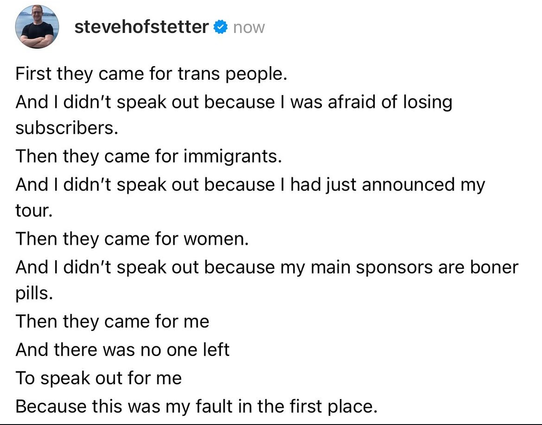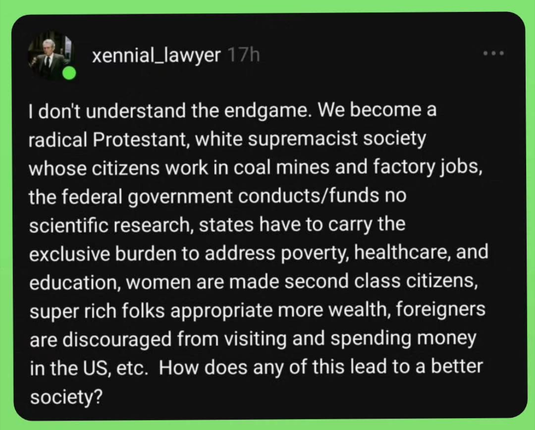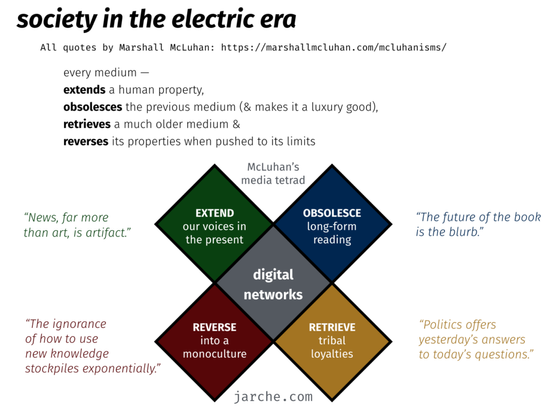If you’re practicing #sensemaking, trust your intuition.
https://mastodon.social/@tzimmer_history/114099967857520689
#senseMaking
Designers don’t just solve problems—they shape how we see them. Learn how #synthesis, #sensemaking, and #problemframing turn complexity into clarity and insight into strategic action.
#USpol #leadership has to practice #sensemaking for a #BodyPolitic that reads at a 5th grade level, is too distracted to finish a book (any book!), and is in deep denial by being subject to the whims of a donor class that believes the #FaceEatingLeopard won’t eat their face.
It’s a lot.
Leadership involves reading the room, knowing what time it is, and understanding the assignment.
They…don’t.
It challenges #sensemaking because it’s not •supposed• to make sense.
So cool to see applied #sensemaking across time and space.
#ontology is “the structured understanding of what exists in your organization, how those things relate, and why they matter.”
#sensemaking #understanding
https://www.linkedin.com/posts/byrdkw_if-youre-exploring-how-ai-agents-operate-activity-7333293383903256577-MdD5?utm_source=share&utm_medium=member_ios&rcm=ACoAAACmWtEBurVmJxUdnv5QtGB6hgFTyYJNROs
When people in politics say something is “dangerous” what they really mean is “cause of street action.”
Ha!
It’s a pre-AI image, for sure.
What wild is this mind map did hold meaning to some group of people, at a point in time and space.
When finding the right terms for self-expression turns into a straight-jacket, what problem are we solving for?
#sensemaking
https://fedi.redhairpale.skin/@maddy/statuses/01JV7JG89A27VNKZT76S65V09S
The president is literally doing impeachable stuff right in front of our eyes!
No cap!
The Dems & few sane Reps oughta call the vote already.
What are they waiting for.
No downsides here.
45’s popularity is in the TRASH.
Ratings are giving major flop vibes.
Dems and sane need some of that main character energy.
Just go for it.
Hit the like button if you think they need to just take the vote!
Or what are they so afraid of?
Yesterday, I had the opportunity to meet Dave Snowden, the creator of the Cynefin framework which helps executives and leaders take action and navigate complex, uncertain situations by first sensing the context in which they need to act. #complexsystem #sensemaking
www.linkedin.com/posts/serges...
Yesterday, I had the opportuni...
I've been cooking/making Korean dishes lately.
Here's how I recently made sense of how to make Jjajangmyeon.
"An Illustrated Story of Culinary Visual Sensemaking" 🧑🍳
https://stephenanderson.medium.com/making-sense-of-making-jjajangmyeon-a20d599c3a13
What Would Putin Do (WWPD) is an effective heuristic for #sensemaking In These Times™
When a technology’s properties are pushed to its limits there is a potential for unintended consequence. A technology can have more than one. When developing a new technology, or deciding whether to regulate one in our society, it would pay to have some deep conversations about these effects.
Just because these consequences are unintended does not mean they are unknown.
Prompting as a literary practice
When working with AI language models, there’s a fundamental distinction between using them to write for us versus engaging with them as reflective partners in our writing process. The most valuable approach may not be the most obvious one.
This doesn’t mean it will always need to be intentionally produced for the model. In fact one of the most effective ways to work with LLMs in your writing, as opposed to using them to write, involves simply sharing paragraphs of what you’ve written with the model in order to generate a response which will cause you to reflect on your ideas. If you have a specific concern, such as identifying counter-arguments or reflecting on how the writing can be improved, these can be included as an instruction e.g. “Please suggest three objections to the argument I make in this paragraph”. But it’s often more constructive to simply paste in the paragraph itself, tacitly inviting the model to respond to the substance of what you’re saying rather than play a particular practical role in relation to it.
For example this is how Claude 3.5 responds when I share these last two paragraphs without any further instruction:
This is a fascinating meta-level analysis of our interaction, particularly as I engage with your text about engaging with AI language models. Let me reflect on what I found most compelling about your argument:
The reframing of prompting from a technical to a literary practice is insightful. You’re suggesting that meaningful interaction with LLMs is fundamentally an act of writing rather than coding or issuing commands. This challenges the dominant ‘input-output’ paradigm.
The notion of ‘expansive writing’ resonates with my experience of our interactions. The most productive exchanges tend to come from humans who provide rich context and developed thoughts, rather than terse instructions.
Your point about the distinction between writing for versus writing with LLMs is particularly astute. There’s a qualitative difference between crafting prompts specifically for AI consumption versus sharing authentic writing and using the models’ response as a reflective tool.
Your argument leads me to wonder about the pedagogical implications: If we frame LLM interaction as a form of creative writing rather than technical skill acquisition, how might this change how we teach students to work with these tools? Should we be drawing more from creative writing pedagogy rather than computer science when teaching ‘prompt engineering’?
Exactly what form responses are likely to take varies between models. I shared the same two paragraphs with the earlier Claude 3 model which responded in more discursive yet cautious manner. It highlighted how “models like myself do have limitations in truly grasping the full depth and nuance of complex writing and arguments” which means their outputs “can certainly be thought-provoking and rhetorically coherent, but may lack the sustained rigor and knowledge integration of an expert human engaging with the same text”. ChatGPT 4 responded in a similar way to Claude 3.5 with an initial reiteration of my argument followed by suggestions for further development. It told me that “Your emphasis on prompting as a literary practice reframes the relationship between users and language models, moving beyond the instrumental, task-orientated perspective often dominant in higher education”. It suggested five different facets of this argument which I could elaborate upon as I continued to develop the chapter. Google’s Gemini offered an even more succinct summary, sharing that this “insightful analysis of the role of prompts in interacting with LLMs … highlights the often overlooked creative and literary aspects of prompting, shifting the focus away from mere technical instruction towards a more nuanced and expressive form of communication”.
Instead of offering points in my argument which could be elaborated on, it identified what it said were the four key elements in what I had shared: prompting as a literary act, the power of expansive writing, tacit invitation and specific instructions. In itself this wasn’t particularly useful but it was helpful to put a phrase (‘tacit invitation’) to a practice I’d struggled to fully articulate, in which the generic disposition of LLMs can be used in interesting ways in the context of writing projects. They revert to generic responses when you provide them with little explicit instruction or role setting, but when sharing large extracts of academic writing it can sometimes be helpful to leave your expectations tacit, in order to see what the model does. This can be particularly helpful when you’re unsure exactly what role it would be helpful for the model to play, you just realize that it would be helpful to have some response to what you have written.
This approach transforms our relationship with AI from one of command-and-output to something more exploratory and dialogic. It reimagines prompting not as a technical skill but as a form of inquiry, where we’re not just extracting information but engaging in a process of collaborative sense-making.
Seen through this lens prompting can take on the qualities we associate with sense-making. Jones (2022: 118) suggest that exploratory writing is a mode of sense-making, alongside thought and conversation, which “forces us to articulate our thinking while at the same time allowing us to explore different ideas and their implications without being swayed by others’ agendas, judgements or assumptions”. Exploratory writing in this sense provides a sphere of internal freedom in which ideas and understandings can be tested out, free from the constraining effects of the reactions which others have to them. Obviously not all prompt writing is exploratory writing in this sense, but the approach I’m advocating often involves exploratory writing.
As Jones (2024: 118) notes there’s “rarely a single, clear narrative we can construct quickly to help us understand accommodate new experiences and thereby restore our equilibrium” which is precisely why models can be so helpful at this stage. They can support us in filtering through the competing narratives and interpretations, helping refine ideas we are not yet ready to voice to others. They provide an environment in which the coherence required of us by others is absent, enabling us to give voice to multiplicity of opinions we inevitably find within us when we look deeply (Jones 2024: 199). They can also take any role we seek in relation this multiplicity, whether from the critical reviewer who cuts down these ambitions through intellectual scrutiny to the careful scribe whose role is to help us record and elaborate on our nascent insights.
“To engage in sensemaking is to construct, filter, frame, create facticity (Turner, 1987), and render the subjective into something more tangible” describes Weick (1995: 14). It is a practical activity on this view, rather than a single discovery which leaves everything changed. It is something we work at in a purposeful way in order to bring about a sense of purchase upon what we are doing. It involves the progressive clarification of our situation, grasping the significance of it for us by, quite literally, making sense of it.
In contrast to the tendency to position models as practical tools for automation, enabling us to work more quickly by outsourcing unwanted tasks, I argue we should see models as tools for sense making. To use them in this way will often involve saving time but this is a secondary benefit which emerges from their contribution to our sensemaking, rather than something pursued as an end in itself. If you approach a model through the lens of trying to save time, finding a way to reduce the number of tasks you’re responsible for and/or enact existing tasks more quickly, it carries a whole set of assumptions with it which will impede sensemaking.
This distinction between automation and sense-making represents two fundamentally different orientations toward AI writing tools. The first sees them primarily as labor-saving devices that can produce text on our behalf; the second sees them as thinking partners that can help us develop our own ideas with greater clarity and depth.
#academicWriting #automation #claude #prompting #senseMaking #writing
Come for the #shitposting, stay for the #sensemaking.
I can’t predict the future, but I can tell which way the puck is moving, and see around corners.
This is my neurospicy superpower and I wield it with responsibility.
Here, in the #Fediverse, with my brothers in Christ.
https://mastodon.world/@paninid/111829300324146720
What we’re experiencing is #SadoPopulism.


